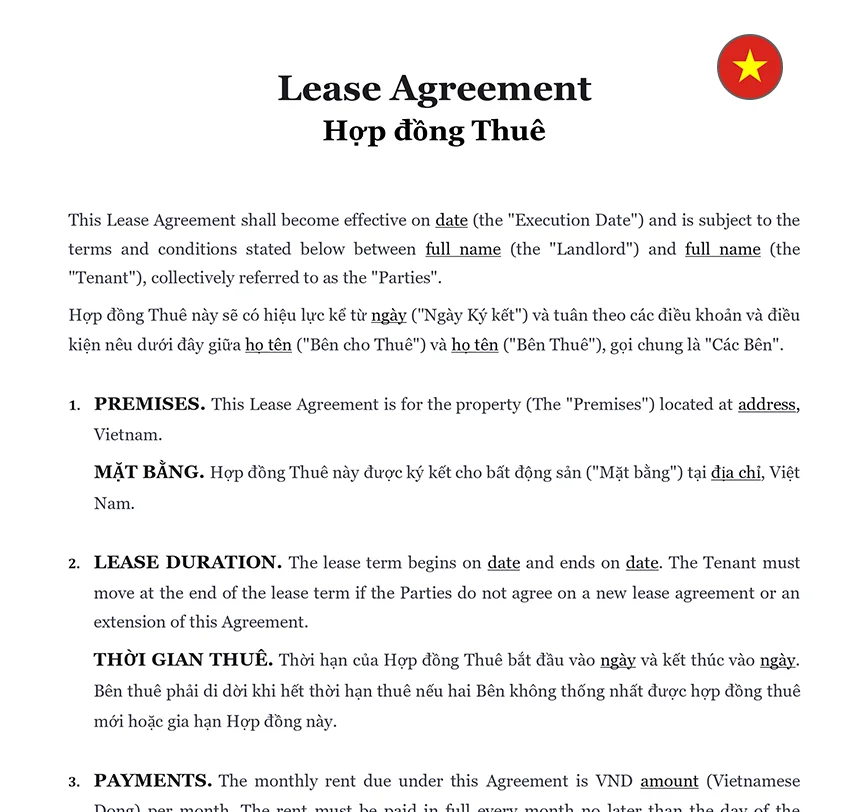Essential Elements of a Rental Contract
A comprehensive rental contract should cover all critical aspects to protect both parties. Key components include:
| ➤ Property Details: Full address, detailed description, and inventory of included items. |
| ➤ Rental Terms: Duration of the lease, start and end dates, and conditions for renewal. |
| ➤ Payment Terms: Exact rent amount, payment due dates, and acceptable payment methods | ➤ Deposits: Security deposit amount, conditions for its return, and allowable deductions. | ➤ Responsibilities: Specific maintenance and repair obligations of both landlord and tenant. | ➤ Termination Clauses: Conditions under which the contract can be terminated early, notice periods, and penalties. | ➤ Legal Requirements: Assurance of compliance with local laws and regulations. |
Use our Lease Agreement Template for comprehensive rental contracts.
Clarity in Lease Agreement Terms
A lease agreement must clearly define the terms to prevent misunderstandings. Key points to include are:
Monthly Rent Amount: Specify the exact amount to be paid each month.
Due Dates for Payments: Clearly state the due dates for rent payments to ensure timely transactions.
Acceptable Payment Methods: Outline acceptable payment methods such as bank transfers, cash, or online payments.
Penalties for Late Payments: Detail penalties for late payments to encourage timely transactions and avoid disputes.
Responsibility for Utilities and Other Costs: Specify who pays for utilities and other costs like maintenance fees to prevent confusion and potential conflicts.
ℹ️ Explore Strategies for Negotiating Office Space Rental in Vietnam for negotiating terms.
Verifying the Legitimacy of the Property Owner
To avoid dealing with fraudulent property owners, follow these essential steps to verify their legitimacy:
1. Request Identification Documents: Ask for the property owner’s identification, such as their ID card or passport, to confirm their identity.
2. Examine Ownership Documents: Review the ownership documents, including the land use rights certificate or house ownership certificate, to ensure they align with the owner’s details.
3. Cross-Check with Local Authorities: Verify the authenticity of these documents with local authorities, such as the district people’s committee, to ensure their validity.
4. Consult Official Resources: For additional guidance on verifying property ownership, visit the official Vietnamese government portal Cổng Thông Tin Điện Tử Chính Phủ.
ℹ️ Read Protecting Your Investment with Vietnam Ground Leases for additional lease protections.
Common Misunderstandings in Rental Contracts
Common misunderstandings often arise from ambiguous clauses or omitted details in rental agreements. Key areas of potential confusion include:
| ➤ Rent Increases: Clarify if and how rent can be increased during the lease term, including the frequency and maximum percentage increase allowed. |
| ➤ Maintenance Responsibilities: Specify whether the landlord or tenant is responsible for repairs and maintenance tasks to avoid disputes over property upkeep. |
| ➤ Utility Payments: Outline which utilities the tenant must pay for and whether these costs are included in the rent or billed separately. | ➤ Terms of Renewal: Clearly define the conditions for lease renewal, including any changes in terms or rent amounts. | ➤ Property Modifications: State the rules regarding property modifications, including whether the tenant needs landlord approval for any changes. | ➤ Guest Policies: Define any restrictions or rules regarding long-term guests or additional occupants. |
ℹ️ Learn from Updating Rental Contracts: A Legal Guide for Landlords for managing contract amendments.
Importance of Clear Payment Terms in Rental Contracts
Clear payment terms in rental contracts are crucial for avoiding disputes and ensuring smooth transactions between tenants and landlords. Important aspects to include are:
Monthly Rent Amount: Explicitly state the rent amount to avoid any ambiguity about what is expected.
Payment Due Dates: Specify the exact due dates for rent payments to ensure timely transactions.
Payment Methods: Clearly indicate acceptable payment methods, such as bank transfers, cash, or online payments, to avoid confusion.
Penalties for Late Payments: Outline any penalties for late payments to encourage timely rent payments.
Additional Fees: Detail any additional fees, such as maintenance charges or service fees, that the tenant is responsible for.
By defining these payment terms in detail, both parties are aware of their financial obligations, reducing the likelihood of disputes and ensuring a harmonious rental relationship.
Use our Rent Receipt Template to document rent payments properly.
Handling Security Deposits Properly in a Rental Contract
Security deposits are often a source of conflict between landlords and tenants. A well-drafted contract should specify the amount of the security deposit, which typically ranges from one to three months’ rent. It should also outline the clear conditions under which the deposit will be refunded, such as the requirement for the tenant to leave the property in good condition. Additionally, the contract should detail situations where deductions from the deposit are permissible, such as for repairs due to tenant damage or unpaid rent. Providing this information upfront helps manage expectations and reduces the potential for disputes at the end of the lease.
Prevent issues with our Rental Inspection Report to document property conditions.
Protecting Against Unforeseen Termination in Rental Contracts
To safeguard both parties in the event of unforeseen termination, ensure your rental contract includes the following elements:
1. Notice Period
Define the required notice period for terminating the lease, typically ranging from one to three months. This provides ample time for both parties to prepare for the change.
2. Conditions for Early Termination
Specify the conditions under which early termination is permitted, such as a breach of contract, job relocation, or other significant changes in circumstances.
3. Penalties for Early Termination
Outline any penalties for terminating the lease without valid reasons. This may include forfeiture of the security deposit or payment of additional fees, which helps discourage unjustified early termination.
4. Rights and Obligations
Clearly articulate the rights and obligations of both parties in the event of early termination. This ensures that each party understands their responsibilities and potential consequences.
ℹ️ Protect your rights using our Eviction Notice Template for clear termination.
Subleasing and Property Modifications in Rental Contracts
Documenting the rules regarding subleasing and property modifications in the rental contract is crucial to prevent future conflicts. Specify whether subleasing is allowed and under what conditions, such as requiring the landlord’s prior written consent. Detail any restrictions or requirements for modifications to the property, including whether the tenant needs to obtain approval from the landlord before making any changes. Clearly stating these terms in the rental contract helps prevent misunderstandings and ensures that both parties are aware of their rights and responsibilities concerning subleasing and property modifications. This clarity can prevent potential disputes and protect the interests of both parties.
- Remarks:
For more information on subleasing, see our Sublease Agreement Template.
Ask your question and receive legal advice from a qualified lawyer
310 client reviews (4.8/5) ⭐⭐⭐⭐⭐











